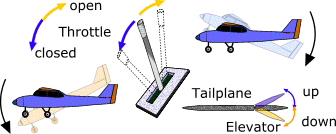

| Primary Flight Control 2 |
This section describes the way in which the transmitter sticks operate the flight controls. For clarity a single stick is used for illustration, but of course on most radios these would be 2-axis sticks, with controls combined. The way the controls are combined can vary, and this is known as the Mode of the transmitter.
Roll
When the aileron stick is moved from side to side, this has the effect of raising or lowering the ailerons on the wing. To make a turn, the aileron on one side is raised, while the aileron on the other side is lowered. The combined effects of the airflow on the controls causes the aircraft to rotate around the fuselage axis, causing a roll.

Yaw
This control is also operated by a side to side motion of the stick. The rudder moves left or right in response and yaws the aircraft. If the stick is moved to the left, the rudder is deflected left and the pressure of the airflow on the rudder moves the tail of the aircraft in the opposite direction producing a yaw. Moving the stick right yaws the aircraft in the opposite direction.

Pitch
The elevator is controlled by moving the stick in the vertical axis. As the stick is pulled back, the elevator is raised and the pressure of the airflow on the control surface pushes the tail of the aircraft down, making the nose pitch up. An upward movement of the stick causes the elevator to deflect downwards with a corresponding pitch down.

These pages have been contributed by Phoenix Model Flying Club, Lowestoft, Suffolk